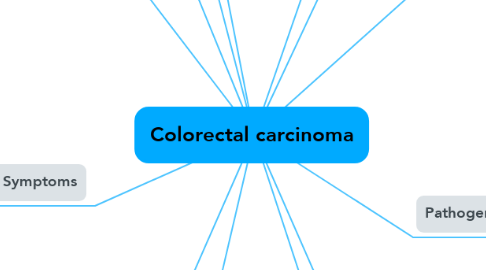
1. finds occult (hidden) blood in the stool through a chemical reaction.
1.1. This test must be done every year
2. Guaiac-based fecal occult blood test (gFOBT
3. Treatment
3.1. Local treatments
3.1.1. Surgery for Colon Cancer Surgery for Rectal Cancer Ablation and Embolization for Colorectal Cancer Radiation Therapy for Colorectal Cancer
3.2. Systemic treatments
3.2.1. Chemotherapy for Colorectal Cancer
3.2.2. Targeted Therapy for Colorectal Cancer
3.2.2.1. Bevacizumab (Avastin) Ramucirumab (Cyramza) Ziv-aflibercept (Zaltrap)
3.2.3. Immunotherapy for Colorectal Cancer
3.2.3.1. PD-1 inhibitors
3.2.3.2. CTLA-4 inhibitor
4. Stages
4.1. TNM system
4.1.1. (size) of the tumor (T)
4.1.2. The spread to nearby lymph nodes (N)
4.1.3. The spread (metastasis) to distant sites (M)
5. Screening Tests
5.1. Fecal immunochemical test (FIT)
5.2. Colonoscopy
5.3. CT colonography
5.4. Flexible sigmoidoscopy
5.4.1. A flexible sigmoidoscopy is similar to a colonoscopy except is doesn’t examine the entire colon.
6. Signs and Symptoms
6.1. A change in bowel habits
6.1.1. diarrhea
6.1.2. constipation
6.1.3. narrowing of the stool that lasts for more than a few days
6.2. Rectal bleeding with bright red blood
6.3. Blood in the stool
6.4. Cramping or abdominal (belly) pain
6.5. fatigue
6.6. weight loss
7. Causes
7.1. Inherited gene mutations
7.1.1. Familial adenomatous polyposis (FAP),
7.1.2. Lynch syndrome
7.1.3. Peutz-Jeghers syndrome
7.1.4. MUTYH-associated polyposis (MAP)
7.2. Acquired gene mutations
8. Risk Factors
8.1. Being overweight or obese
8.2. Not being physically active
8.3. Certain types of diets
8.4. Smoking
8.5. Alcohol use
8.6. Old age
8.7. A personal history of colorectal polyps or colorectal cancer
8.8. A personal history of inflammatory bowel disease
8.9. family history of colorectal cancer
9. Types
9.1. Carcinoid tumors.
9.2. Gastrointestinal stromal tumors (GISTs
9.3. Lymphomas
9.4. Sarcomas
10. Morphology
10.1. Cecum
10.1.1. ascending colon, 22%
10.1.2. transverse colon 11%
10.1.3. descending colon 6%
10.1.4. rectosigmoid colon 55%
10.1.5. other sites, 6%
11. Pathogenesis
11.1. dietary factors
11.1.1. (1) excess dietary caloric intake relative to requirements
11.1.2. 2) a low content of un-absorbable vegetable fiber
11.1.3. 3) a corresponding high content of refined carbohydrates
11.1.4. 4) intake of red meat
11.1.5. 5) decreased intake of protective micronutrients (like vitamins
12. Colorectal cancer starts in the colon or the rectum. These cancers can also be called colon cancer or rectal cancer, depending on where they start.
12.1. Colon
12.1.1. ascending
12.1.2. Transverse colon
12.1.3. descending colon
12.1.4. sigmoid colon (in false pelvis)
